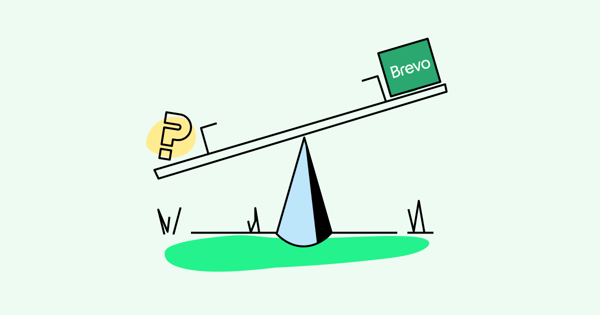Sendinblue carved out a niche as a high-quality, low-cost email marketing platform. It might have lacked some of the bells and whistles of premium tools, but it did all the essentials well — and at a fraction of the price of its rivals.
Things changed somewhat in May 2023, when the platform bolted on CRM functionality as part of its rebranding to Brevo. Not only is it still cheap, but it also does a ton of extra stuff.
(N.B. Because Brevo is a new — and comparatively unknown — name, we’ll mostly refer to it as Sendinblue throughout this article.)
With all that additional functionality, is Sendinblue/Brevo a no-brainer for budget-conscious businesses?
It depends on your needs. But there’s no shortage of Sendinblue alternatives out there. Some are better catered to specific industries; others have more advanced features; some offer more generous feature sets. To help you make the right choice for your business, we’ve compared the top 10 Sendinblue alternatives by:
- Price
- Product features
- Customer support
- Pros and cons
- Target audience
Let’s get into it…
What Are the Best Sendinblue Alternatives?
| Sendinblue Alternatives | Best For | Top Features | Pricing/ Month |
| Drip | DTC ecommerce | Segment your whole audience based on real-time store, visitor, and marketing data. | From $39 per month for up to 2,500 contacts and unlimited email sends. |
| Klaviyo | Ecommerce agencies and developers | Personalization and segmentation tools allow you to create customer segments based on real-time data. | Free for up to 250 contacts and 500 monthly email sends; paid plans priced from $45 per month for up to 1,000 contacts and 10,000 monthly email sends. |
| Mailchimp | Small businesses | Advanced analytics and reporting help marketers make data-driven decisions. | Free for up to 500 contacts and 1,000 monthly email sends; paid plans start at $9.99 per month for 500 contacts and 5,000 monthly email sends. |
| Omnisend | Ecommerce marketers | Web push notifications allow brands to instantly retarget customers. | Free to reach up to 250 contacts per month, including 500 monthly email sends. Paid plans start at $16 per month to reach up to 500 contacts. |
| AWeber | Startups and small businesses | Create email templates in seconds using your website or Facebook page URL. | Free for up to 500 email subscribers and 3,000 monthly email sends; paid plans priced from $16.15 per month for up to 2,500 subscribers. |
| ConvertKit | Content creators | Integrated newsletter referral program helps creators grow their reach by leveraging their existing audience. | Free for up to 1,000 subscribers and unlimited email sends; paid plans start at $9 per month for up to 300 subscribers and unlimited sends. |
| ActiveCampaign | Advanced marketers who need high-level automation | Predictive actions use machine learning to deliver customer experiences based on data, such as the best time to send emails. | From $29 per month for one user and unlimited emails. |
| Constant Contact | Nonprofits and charities | Manage campaigns on the go from a dedicated mobile app. | From $9.99 per month for up to 500 contacts and 12,000 monthly email sends. |
| GetResponse | Small businesses that need advanced marketing tools | Built-in GPT-3.5 powered email generator. | Free for up to 500 contacts and 2,500 monthly email sends. Paid plans start at $15.58 per month for 1,000 contacts and unlimited email sends. |
| HubSpot | B2B inbound marketing | Connect marketing, sales, content management, and customer service in a single platform. | Free marketing plan includes unlimited contacts and 2,000 monthly email sends. Paid marketing plans start at $18 per month for 1,000 contacts and 5,000 monthly sends. |
The 10 Best Sendinblue Alternatives
1. Drip
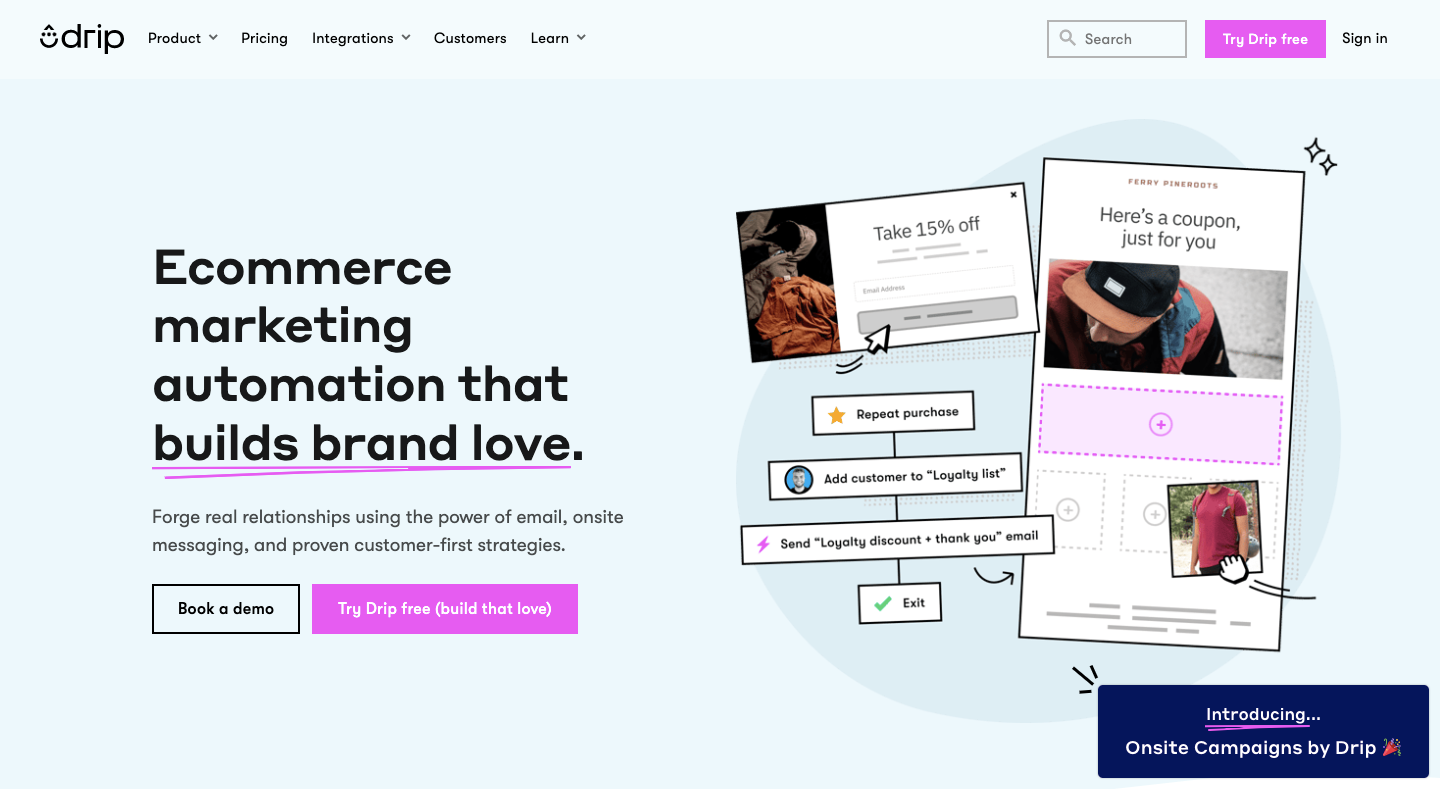 This is our article, so you can forgive us for starting with our own platform. Drip does marketing automation for ecommerce businesses (with a particular focus on DTC brands). We help ecommerce marketers create highly personalized, revenue-driving email and onsite campaigns — without requiring any advanced technical skills. No wonder thousands of brands trust us to engage their audiences and grow their sales.
This is our article, so you can forgive us for starting with our own platform. Drip does marketing automation for ecommerce businesses (with a particular focus on DTC brands). We help ecommerce marketers create highly personalized, revenue-driving email and onsite campaigns — without requiring any advanced technical skills. No wonder thousands of brands trust us to engage their audiences and grow their sales.
What Makes Drip the Best Sendinblue Alternative?
- Made for ecommerce businesses. Sendinblue has some useful features for ecommerce brands, including the ability to send transactional emails on all price plans (even the free one). But it’s not a dedicated ecommerce platform, so it doesn’t have the depth of ecommerce-specific segmentation and automation features offered by Drip.
- Ecommerce-focused development pathway. Sendinblue serves businesses in multiple industries, from automotive to media and publishing to NGOs. Because it has to keep them all satisfied, there’s little incentive to introduce new features that only benefit a small proportion of customers. By contrast, Drip is 100 percent focused on ecommerce — and so is our development pathway. Everything we do is designed to help you generate more leads, sales, and revenue.
- Revenue-focused reporting. Sendinblue’s reports are a little tricky to read — and if you’re on the Starter plan (or below), you only get limited access to data. On the flip side, all Drip customers can leverage the full power of our revenue-focused reports, helping them understand the value of every single automation and email. We even tell you exactly how much revenue you’ve generated through Drip campaigns.
- Advanced onsite ecommerce marketing. We recently added advanced onsite marketing to our toolkit with the addition of Sleeknote, a feature-rich onsite form and popup-building platform — helping our users reach customers beyond the inbox. Sendinblue has a solid, easy-to-use form-builder, but it lacks Drip’s depth of personalization and customization.
- UI built for ecommerce. Because Drip is built from the ground up for ecommerce businesses, our interface only includes the stuff you need, making it easy to navigate. Sendinblue is a more generalist platform, so it inevitably has tools that weren’t designed for non-ecommerce brands.
- Dedicated support for ecommerce brands. Ecommerce marketing is our bread and butter — and we’re happy to share our knowledge. Our support team is happy to pull up a chair, get under the bonnet of your ecommerce strategy, and provide recommendations tailored specifically to your brand. Sendinblue’s support is perfectly competent, but you’ll need to subscribe to its top-tier Plus plan to unlock personalized support.
How Does Drip Compare to Sendinblue?
| Drip | Sendinblue | |
| Best Feature | Segment your whole audience based on real-time store, visitor, and marketing data. | Send transactional emails with guaranteed 97 percent deliverability. |
| Best For | DTC ecommerce | Low-budget email marketing |
| Pros | A dedicated ecommerce platform, not a generalist tool. | Cheaper prices and more all-round functionality. |
| Cons | If you’re not in ecommerce, Drip isn’t the best fit. | Weaker (and less revenue-focused) reporting and insights. |
| Pricing/Month | From $39 per month for up to 2,500 contacts and unlimited email sends. | Free for unlimited contacts and up to 300 emails per day. Paid plans start at $25 per month for unlimited contacts and 20,000 emails per month. |
| Support | Our support is rated 8.8 on G2 (vs. an average of 8.6 for marketing automation platforms) and includes live audio screen sharing to solve problems in real time. | The $25+ per month Starter plan only offers email-based support. To receive personalized support, you’ll need to subscribe to an Enterprise plan. |
2. Klaviyo
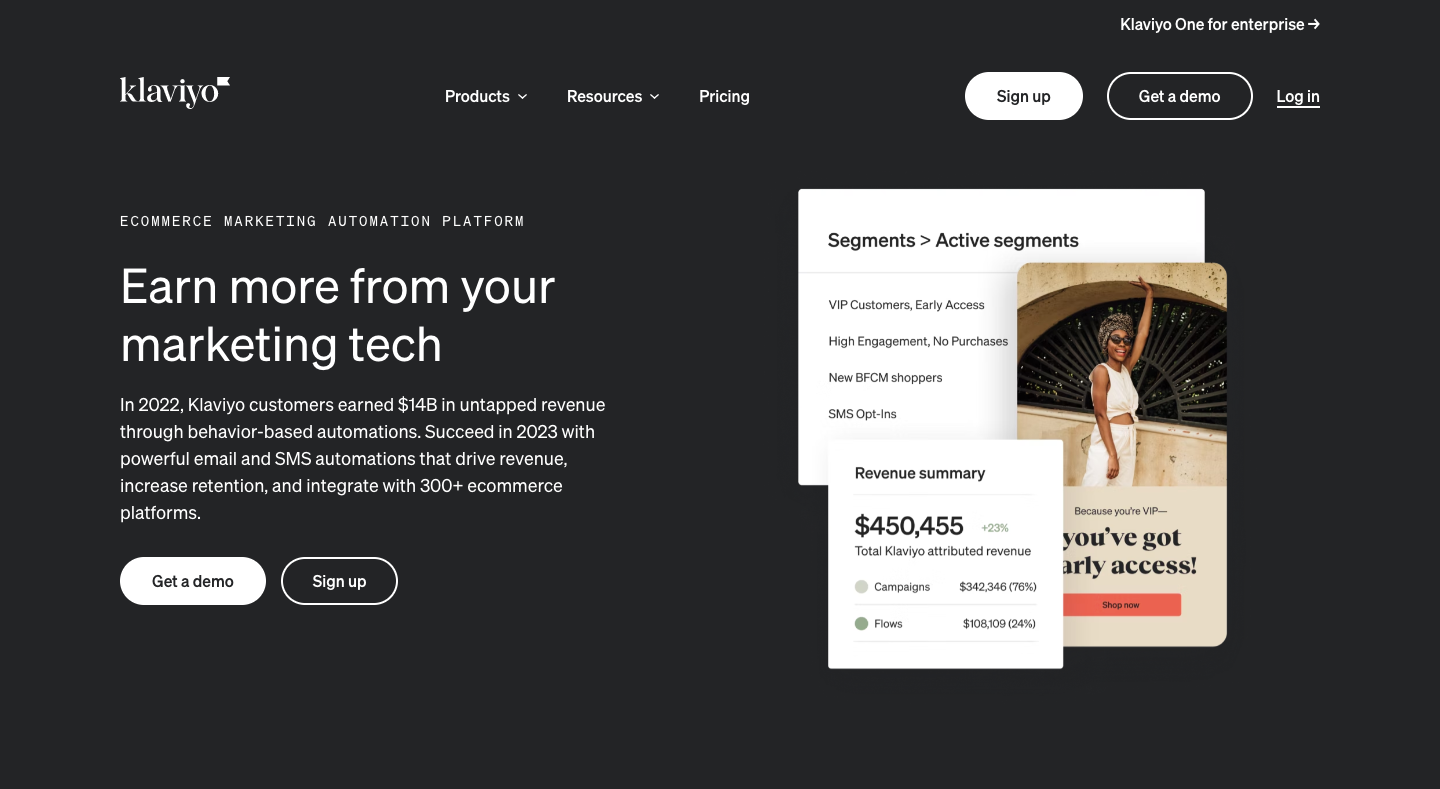 Klaviyo is another marketing automation platform for ecommerce businesses — although, unlike Drip, you’ll need a full-service Klaviyo agency or an in-house dev team to take full advantage of its features. As such, it’s a popular choice among big brands and retailers.
Klaviyo is another marketing automation platform for ecommerce businesses — although, unlike Drip, you’ll need a full-service Klaviyo agency or an in-house dev team to take full advantage of its features. As such, it’s a popular choice among big brands and retailers.
What Makes Klaviyo the Best Sendinblue Alternative?
- Ecommerce-specific functionality. Assuming you’re an ecommerce business (with a substantial budget and sufficient technical capabilities), Klaviyo does a better job than Sendinblue, simply because it’s a dedicated ecommerce automation platform.
- More ecommerce integrations. Sendinblue claims to offer 150+ integrations (although browsing its list, we could only see 63 at time of writing). Klaviyo, meanwhile, features 300+ pre-built integrations, including popular ecommerce tools like Gorgias and LoyaltyLion.
- More ecommerce templates. Again, this one’s a simple numbers game: Sendinblue offers 60+ fully customizable email templates. But Klaviyo has 100+ templates across email, SMS, forms, and automations. So it takes the prize here.
- Ecommerce-focused reporting. Klaviyo’s reporting tool is superb, with pre-built and fully customizable dashboards that visualize all your KPIs in a single place. Sendinblue is far more limited here, especially at lower price points.
- Predictive analytics. Klaviyo’s superior data science-driven features are capable of forecasting when a customer will place their next order, and even calculate their predicted lifetime value, churn risk, and spending potential. Sendinblue can’t compete here.
Is Klaviyo too expensive? Check out our piece on the best Klaviyo alternatives on the market.
How Does Klaviyo Compare to Sendinblue?
| Klaviyo | Sendinblue | |
| Best Feature | Personalization and segmentation tools allow you to create customer segments based on real-time data. | Send transactional emails with guaranteed 97 percent deliverability. |
| Best For | Ecommerce agencies and developers | Low-budget email marketing |
| Pros | Superior, revenue-focused reporting — including predictive analytics. | Easy to use and significantly cheaper; has a much more generous free plan. |
| Cons | Requires advanced technical skills (or, ideally, a full-service Klaviyo agency) to use it effectively. | Can’t compete on reporting and analytics. |
| Pricing/Month | Free for up to 250 contacts and 500 monthly email sends; paid plans priced from $45 per month for up to 1,000 contacts and 10,000 monthly email sends. | Free for unlimited contacts and up to 300 emails per day. Paid plans start at $25 per month for unlimited contacts and 20,000 emails per month. |
| Support | After the extensive onboarding program, support is limited to live chat and emails. | The $25+ per month Starter plan only offers email-based support. To receive personalized support, you’ll need to subscribe to an Enterprise plan. |
3. Mailchimp
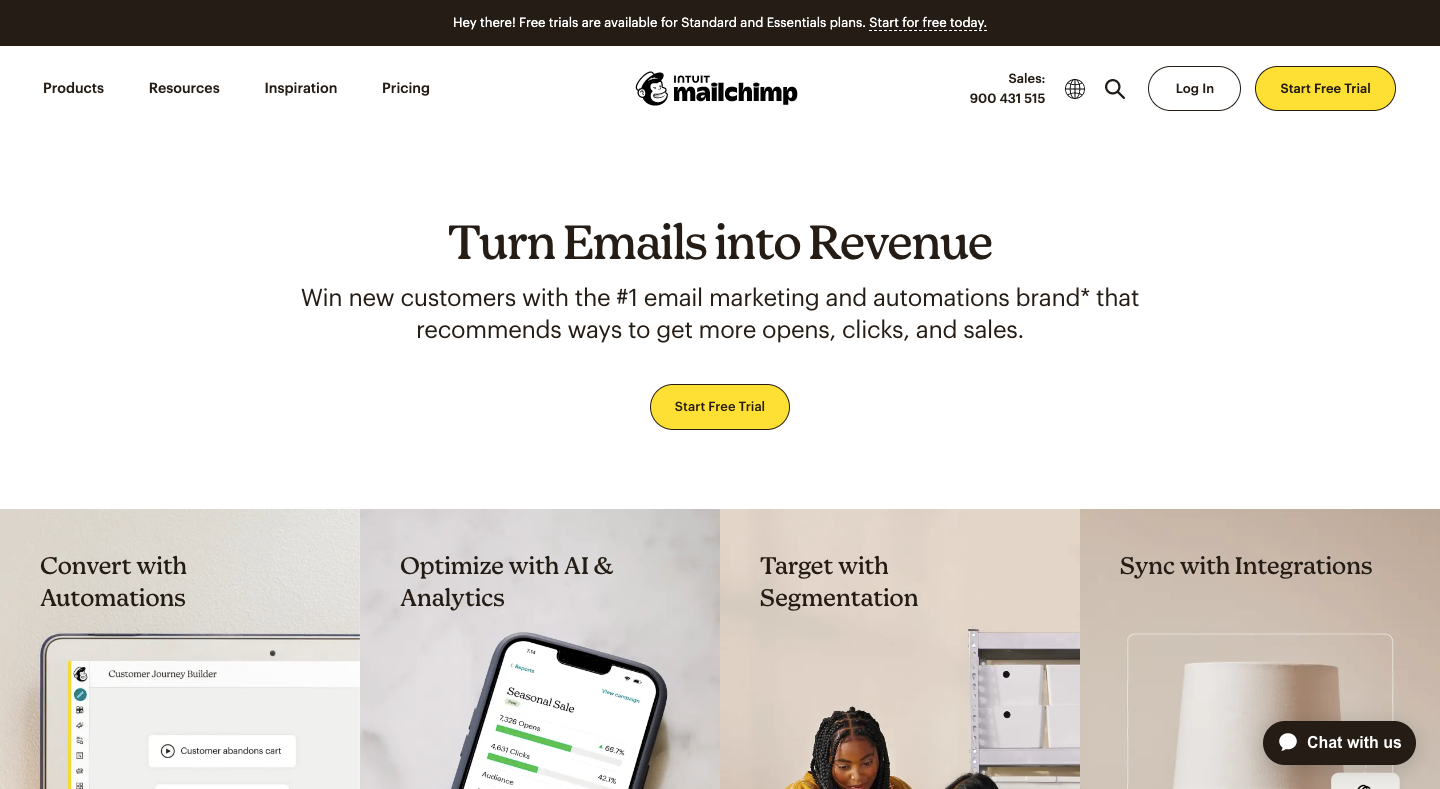 Millions of businesses use Mailchimp. So many, in fact, that the platform has an astonishing 66 percent market share among email marketing tools. But the most popular option isn’t always the best (especially given that Mailchimp has increased its prices and reduced functionality on lower price plans). So is Mailchimp one of the better Sendinblue alternatives?
Millions of businesses use Mailchimp. So many, in fact, that the platform has an astonishing 66 percent market share among email marketing tools. But the most popular option isn’t always the best (especially given that Mailchimp has increased its prices and reduced functionality on lower price plans). So is Mailchimp one of the better Sendinblue alternatives?
What Makes Mailchimp the Best Sendinblue Alternative?
- More email templates. Sendinblue’s email templates are solid and available to all customers, even those on the free plan. However, it lacks the variety of Mailchimp’s (100+) email templates — albeit not all of those are accessible through Mailchimp’s free account. Mailchimp also allows you to code or upload your own templates.
- Free landing page builder. Sendinblue offers one of the best free plans on the market, but it doesn’t include landing page-building functionality. By contrast, Mailchimp’s landing page builder is available to all users, even those on the free account.
- More advanced reporting. We’ve already noted Sendinblue’s reporting limitations, and Mailchimp has the edge here too — in part because Sendinblue lacks social and ecommerce reports.
- More integrations. Mailchimp is a better-known tool, so it’s no surprise that it offers far more integrations than Sendinblue (approximately twice as many). That said, Sendinblue has a Zapier integration, offering access to thousands more tools and platforms.
Mailchimp too simple for your needs? Check out our best Mailchimp alternatives for ecommerce.
How Does Mailchimp Compare to Sendinblue?
| Mailchimp | Sendinblue | |
| Best Feature | Advanced analytics and reporting help marketers make data-driven decisions. | Send transactional emails with guaranteed 97 percent deliverability. |
| Best For | Small businesses | Low-budget email marketing |
| Pros | Better reporting and a free landing page builder. | Cheaper prices and free transactional emails. |
| Cons | Significantly more expensive, despite having similar feature sets. | Less sophisticated reporting, with no social or ecommerce tracking (at least, not without integrations). |
| Pricing/Month | Free for up to 500 contacts and 1,000 monthly email sends; paid plans start at $9.99 per month for 500 contacts and 5,000 monthly email sends. | Free for unlimited contacts and up to 300 emails per day. Paid plans start at $25 per month for unlimited contacts and 20,000 emails per month. |
| Support | Paid plans include 24/7 support via chat and email. Phone and priority support is only available to Premium customers paying $350+ per month. | The $25+ per month Starter plan only offers email-based support. To receive personalized support, you’ll need to subscribe to an Enterprise plan. |
4. Omnisend
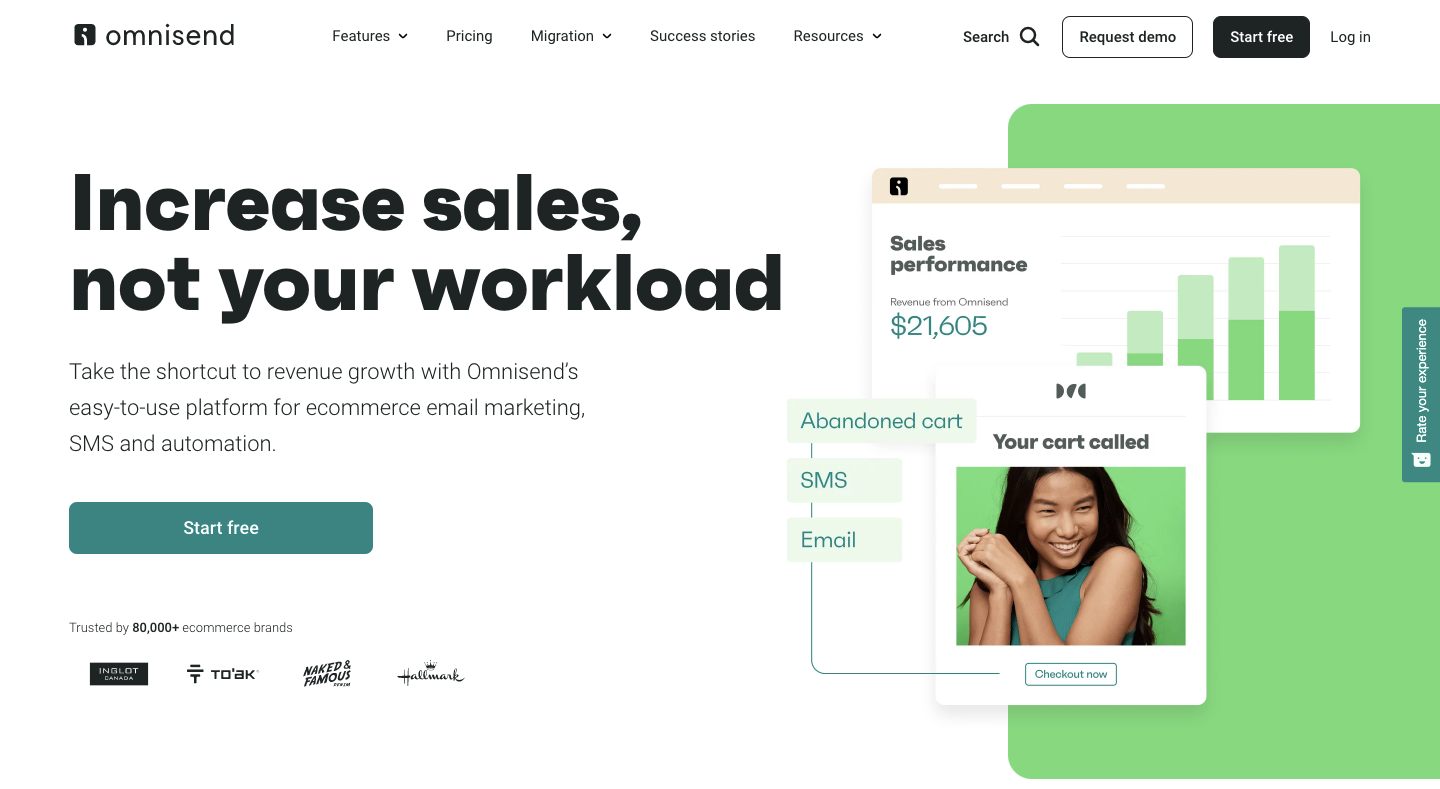 Another ecommerce-focused marketing automation platform, Omnisend helps brands reach and engage their audiences via email, SMS, and push notification campaigns. More than 100,000 businesses use Omnisend, including major names like Hallmark.
Another ecommerce-focused marketing automation platform, Omnisend helps brands reach and engage their audiences via email, SMS, and push notification campaigns. More than 100,000 businesses use Omnisend, including major names like Hallmark.
What Makes Omnisend the Best Sendinblue Alternative?
- Extra free tools. Sendinblue’s free plan is excellent — and if you’re purely looking to send marketing and transactional emails, it definitely wins here. But Omnisend offers some nice extras that Sendinblue lacks, including A/B testing and up to 500 web push notifications.
- Ecommerce-centric reports. Omnisend’s reporting is built for ecommerce businesses, focusing on revenue attribution and reporting. It’s also easy to find valuable ecommerce reports, like revenue per campaign. As we’ve noted before, Sendinblue’s reporting isn’t great (and it lacks ecommerce tracking as standard).
- More support options. Sendinblue offers good support and an excellent knowledge base, but if you’re on a lower price plan, you’ll have to cope with reaching them via email. Meanwhile, Omnisend offers 24/7 email and live chat support on all plans (while Pro and Enterprise-level customers can also access a dedicated customer success manager at an additional one-off cost).
- More email templates. Omnisend’s library includes 100 ecommerce email templates, all of which are available across all price plans. Sendinblue has fewer templates — and not all are relevant to ecommerce businesses.
How Does Omnisend Compare to Sendinblue?
| Omnisend | Sendinblue | |
| Best Feature | Web push notifications allow brands to instantly retarget customers. | Send transactional emails with guaranteed 97 percent deliverability. |
| Best For | Ecommerce marketers | Low-budget email marketing |
| Pros | In-depth, revenue-focused reporting. | Send more emails to more people for less money; also offers a built-in CRM. |
| Cons | More expensive across all paid price plans and email volumes. | Less sophisticated reporting with less focus on revenue metrics. |
| Pricing/Month | Free to reach up to 250 contacts per month, including 500 monthly email sends, up to 60 SMS messages, and up to 500 web push notifications. Paid plans start at $16 per month to reach up to 500 contacts (including unlimited push notifications). | Free for unlimited contacts and up to 300 emails per day. Paid plans start at $25 per month for unlimited contacts and 20,000 emails per month. |
| Support | All users get 24/7 email and live chat support, while Pro and Enterprise subscribers also get a dedicated customer success manager. | The $25+ per month Starter plan only offers email-based support. To receive personalized support, you’ll need to subscribe to an Enterprise plan. |
5. AWeber
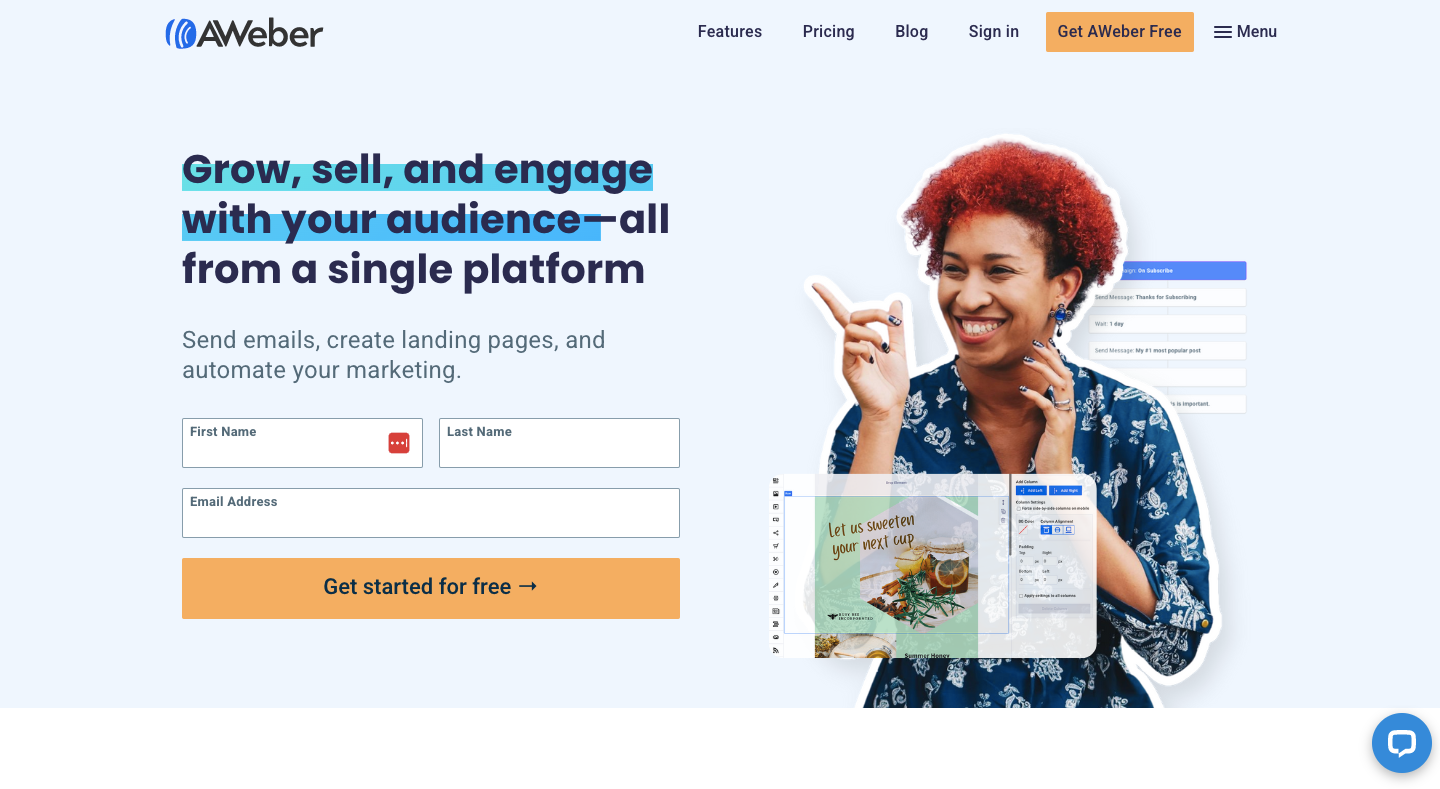 Theoretically, AWeber and Sendinblue are targeting similar audiences: startups, solopreneurs, and small businesses looking for low-cost, high-value digital marketing tools. So which is best?
Theoretically, AWeber and Sendinblue are targeting similar audiences: startups, solopreneurs, and small businesses looking for low-cost, high-value digital marketing tools. So which is best?
What Makes AWeber the Best Sendinblue Alternative?
- Huge range of email templates. AWeber offers one of the largest template libraries on the market, giving users access to over 600 different email and newsletter templates. Not all of them are super-high quality, but if we’re going purely on the numbers here, AWeber has the edge.
- More integrations. Again, this one’s a numbers game — and AWeber wins it hands down, offering 750+ integrations. By contrast, Sendinblue claims to offer over 150.
- Over-the-phone support. AWeber is one of the few platforms to offer phone-based support on all (paid) price plans. With Sendinblue, you’ll have to pay $65+ per month for the Business plan to unlock over-the-phone support.
- (More) free push notifications. Free AWeber users can send web push notifications to up to 50,000 subscribers per month, while Sendinblue’s free plan limits push notifications to just 500 monthly impressions.
- (Slightly) better email deliverability. According to Email Deliverability Report, AWeber performs slightly better than Sendinblue in deliverability tests. The more inboxes you reach, the more revenue you can generate.
How Does AWeber Compare to Sendinblue?
| AWeber | Sendinblue | |
| Best Feature | Create email templates in seconds using your website or Facebook page URL. | Send transactional emails with guaranteed 97 percent deliverability. |
| Best For | Startups and small businesses | Low-budget email marketing |
| Pros | Much higher quantity of email templates and integrations. | Cheaper prices and a more generous free plan. |
| Cons | Significantly higher prices — hard to justify given the similar feature sets. | AWeber only wins on extremely niche use cases (like volume of push notifications on the free plan); for most customers, Sendinblue is a better fit. |
| Pricing/Month | Free for up to 500 email subscribers and 3,000 monthly email sends; paid plans priced from $16.15 per month for up to 2,500 subscribers. | Free for unlimited contacts and up to 300 emails per day. Paid plans start at $25 per month for unlimited contacts and 20,000 emails per month. |
| Support | All users — even free subscribers — can access 24/7 live support via phone, email, and chat (although paying customers are placed in a priority queue). | The $25+ per month Starter plan only offers email-based support. To receive personalized support, you’ll need to subscribe to an Enterprise plan. |
6. ConvertKit
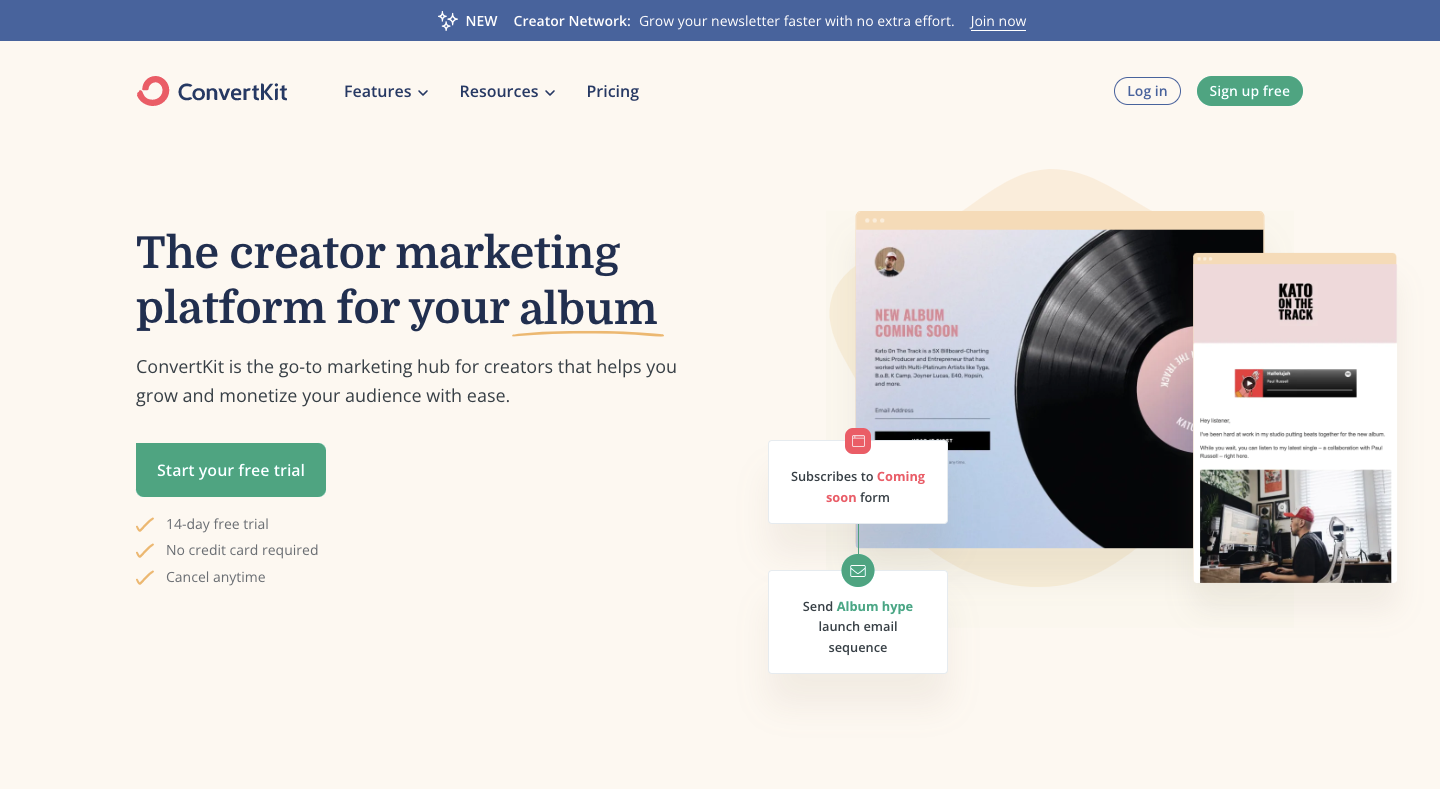 ConvertKit is something of an outlier in our report on Sendinblue alternatives, because it’s neither a generalist tool nor an ecommerce-focused automation platform. Instead, it’s designed for content creators — coaches, authors, podcasters, and musicians. With its low pricing, ConvertKit has amassed well over half a million customers. But how does it measure up to a more generalist platform like Sendinblue?
ConvertKit is something of an outlier in our report on Sendinblue alternatives, because it’s neither a generalist tool nor an ecommerce-focused automation platform. Instead, it’s designed for content creators — coaches, authors, podcasters, and musicians. With its low pricing, ConvertKit has amassed well over half a million customers. But how does it measure up to a more generalist platform like Sendinblue?
What Makes ConvertKit the Best Sendinblue Alternative?
- Built for creators. Without wishing to state the obvious, ConvertKit’s biggest point of difference is its focus on supporting content creators. All its features are designed for creators, whereas Sendinblue caters to businesses across various industries.
- “Free” referral marketing. Creator Pro-level ConvertKit customers get inclusive access to SparkLoop’s referral marketing platform, giving them a free and easy way to expand their audience. Sendinblue doesn’t currently integrate directly with SparkLoop (or any other referral platform, as far as we can tell).
- Join the ConvertKit Creator Network. All (paying) ConvertKit users can access the platform’s Creator Network, allowing them to recommend — and be recommended by — other creators. It’s another low-effort, high-reward way to expand your audience. Sendinblue doesn’t offer anything comparable.
- Earn sponsorship revenue. If you’ve got 10,000+ newsletter subscribers, ConvertKit will help you monetize your content through paid sponsorship opportunities. Unsurprisingly, Sendinblue — which isn’t built for content creators — doesn’t have a similar feature.
- Better value for small email lists. If you have no more than 1,000 subscribers, you can send unlimited emails free of charge through ConvertKit. Sendinblue generally offers better value for larger accounts, though.
How Does ConvertKit Compare to Sendinblue?
| ConvertKit | Sendinblue | |
| Best Feature | Integrated newsletter referral program helps creators grow their reach by leveraging their existing audience. | Send transactional emails with guaranteed 97 percent deliverability. |
| Best For | Content creators | Low-budget email marketing |
| Pros | Lots of creator-friendly tools to grow your audience and monetize your content. | Generally cheaper and a better fit for non-content creators. |
| Cons | More expensive for larger email lists; not a good fit for anyone other than content creators. | Lacks ConvertKit’s specialist extras, like built-in newsletter monetization. |
| Pricing/Month | Free for up to 1,000 subscribers and unlimited email sends; paid plans start at $9 per month for up to 300 subscribers and unlimited sends. | Free for unlimited contacts and up to 300 emails per day. Paid plans start at $25 per month for unlimited contacts and 20,000 emails per month. |
| Support | Paying customers get live chat and email support, with priority access offered to Creator Pro subscribers. Free subscribers only get community support. | The $25+ per month Starter plan only offers email-based support. To receive personalized support, you’ll need to subscribe to an Enterprise plan. |
7. ActiveCampaign
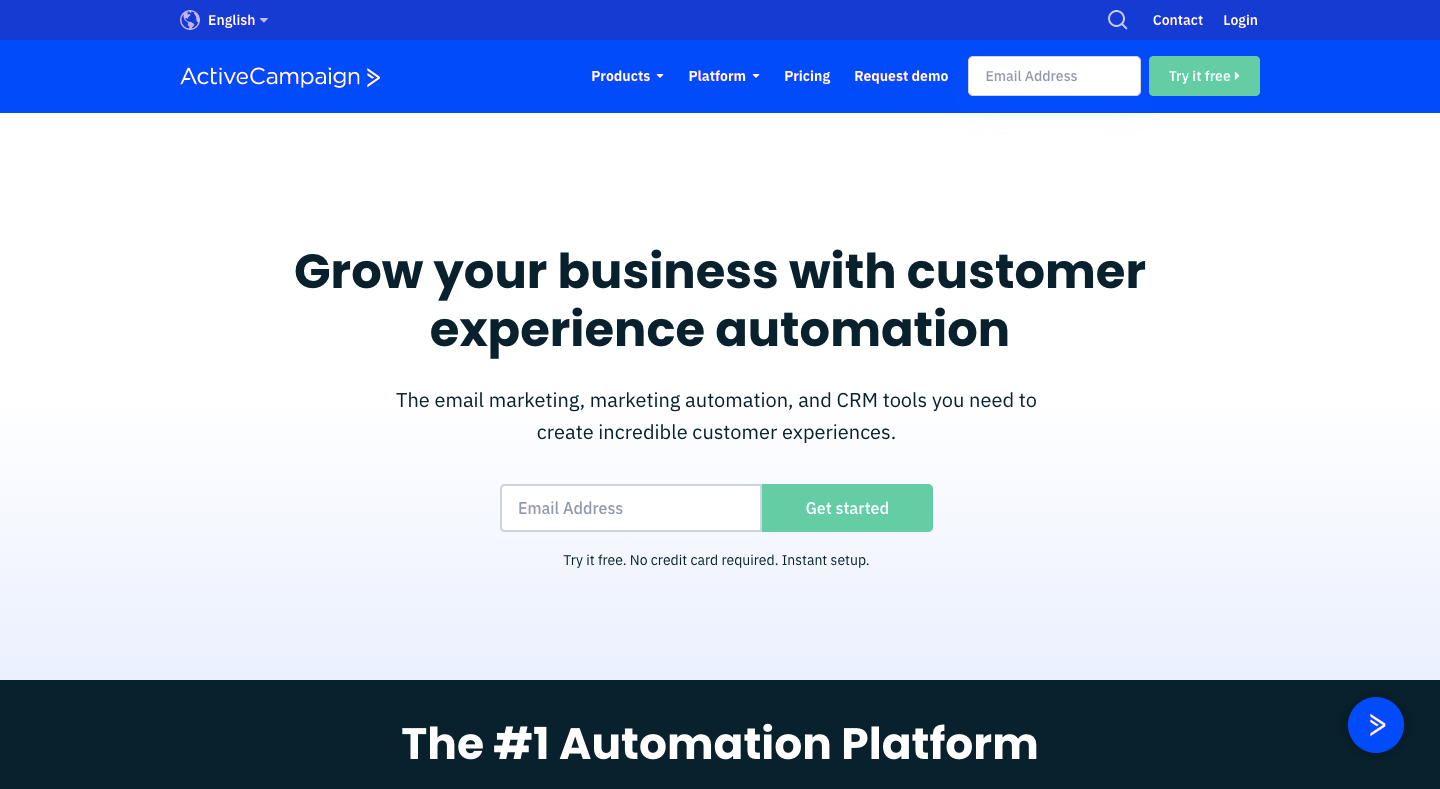 ActiveCampaign is an email marketing, marketing automation, and CRM platform that targets businesses across a wide range of industries, including education, healthcare, and tech. It’s used by 150,000+ small businesses in over 170 countries.
ActiveCampaign is an email marketing, marketing automation, and CRM platform that targets businesses across a wide range of industries, including education, healthcare, and tech. It’s used by 150,000+ small businesses in over 170 countries.
What Makes ActiveCampaign the Best Sendinblue Alternative?
- Machine learning-driven predictive actions. ActiveCampaign uses machine learning to optimize campaign performance, such as sending emails when contacts are most likely to open them. Sendinblue doesn’t (currently) offer anything similar.
- AI-powered content creation. With ActiveCampaign, users can take advantage of machine learning and NLP algorithms to craft personalized, engaging content tailored to their business and audience in a matter of seconds. Again, Sendinblue can’t compete here.
- Integrate with (pretty much) everything. ActiveCampaign has native integrations with over 920 apps across 20+ categories, from analytics to customer support (and, of course, ecommerce). There aren’t too many glaring omissions in Sendinblue’s integrations library, but it integrates with far fewer tools and platforms.
- More email templates. ActiveCampaign’s email templates are excellent — and there are lots of them (over 250, to be precise). Sendinblue has far fewer, although they are at least available on the platform’s free plan.
- Better value for smaller email lists. ActiveCampaign charges by number of contacts, whereas Sendinblue bills on email volume. As such, ActiveCampaign works out cheaper for smaller list sizes. For instance, if you only have 1,000 contacts, you get unlimited emails (and a ton of other features) for $49 per month, whereas Sendinblue charges $65 per month for unlimited contacts and 20,000 emails.
How Does ActiveCampaign Compare to Sendinblue?
| ActiveCampaign | Sendinblue | |
| Best Feature | Predictive actions use machine learning to deliver customer experiences based on data, such as the best time to send emails. | Send transactional emails with guaranteed 97 percent deliverability. |
| Best For | Advanced marketers who need high-level automation | Low-budget email marketing |
| Pros | Better value for smaller list sizes; nice AI and machine learning features. | Cheaper for sending higher volumes of emails (all paid plans include unlimited emails). |
| Cons | Harder for less-experienced marketers to get to grips with the platform. | Lacks some of ActiveCampaign’s more advanced features (like predictive actions). |
| Pricing/Month | From $29 per month for one user and unlimited emails. | Free for unlimited contacts and up to 300 emails per day. Paid plans start at $25 per month for unlimited contacts and 20,000 emails per month. |
| Support | All ActiveCampaign plans offer 24/7 email and chat-based support, but only Enterprise customers get over-the-phone support. | The $25+ per month Starter plan only offers email-based support. To receive personalized support, you’ll need to subscribe to an Enterprise plan. |
8. Constant Contact
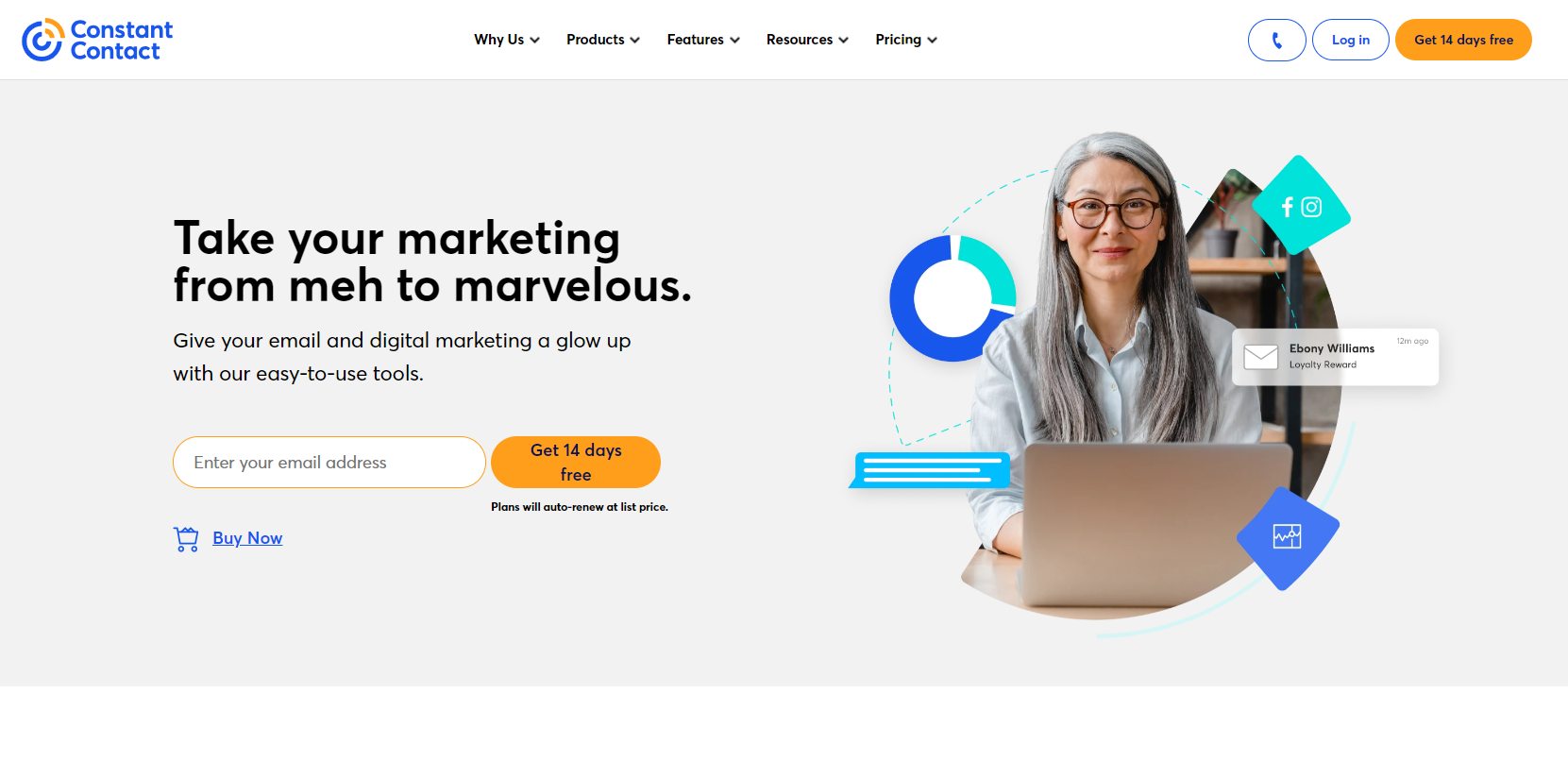 Constant Contact is certainly one of the oldest email marketing tools, having launched way back in 1995. Unsurprisingly, it’s evolved a little over the past three decades and now supports a wealth of additional functionality, including SMS messaging, social media, and automation.
Constant Contact is certainly one of the oldest email marketing tools, having launched way back in 1995. Unsurprisingly, it’s evolved a little over the past three decades and now supports a wealth of additional functionality, including SMS messaging, social media, and automation.
What Makes Constant Contact the Best Sendinblue Alternative?
- Built-in social scheduling. Sendinblue’s social media management tools are limited to building Facebook ads, whereas Constant Contact allows you to schedule organic posts — and run ads across Facebook, Instagram, Twitter, and LinkedIn.
- Phone-based support. Sendinblue customers only get over-the-phone support at Business level and above, whereas all Constant Contact customers can speak to support agents over the phone.
- Built-in event marketing. A niche use case, but a potentially valuable one: Constant Contact offers built-in event marketing tools, allowing users to create customizable registration forms and email invitations, sell tickets, and track RSVPs. Sendinblue doesn’t do any of that without a third-party integration.
- More email templates. Sendinblue’s templates are excellent — there just aren’t that many of them. By contrast, Constant Contact claims to offer hundreds of email marketing templates (albeit some look a little dated).
- More integrations. Another easy one: Constant Contact offers twice as many native integrations as Sendinblue, so it’s the obvious winner here.
How Does Constant Contact Compare to MailerLite?
| Constant Contact | Sendinblue | |
| Best Feature | Manage campaigns on the go from a dedicated mobile app. | Send transactional emails with guaranteed 97 percent deliverability. |
| Best For | Nonprofits and charities (they save up to 30 percent on standard Constant Contact prices) | Low-budget email marketing |
| Pros | Built-in social scheduling and event marketing. | Offers most of the same tools as Constant Contact, but at a lower price. |
| Cons | No free tier and much higher prices. | Fewer integrations; lacks nice-to-have features like social scheduling. |
| Pricing/Month | From $9.99 per month for up to 500 contacts and 12,000 monthly email sends. | Free for unlimited contacts and up to 300 emails per day. Paid plans start at $25 per month for unlimited contacts and 20,000 emails per month. |
| Support | Both paid plans offer live chat and phone support, while Constant Contact Plus subscribers also get personalized consultations to improve performance. | The $25+ per month Starter plan only offers email-based support. To receive personalized support, you’ll need to subscribe to an Enterprise plan. |
9. GetResponse
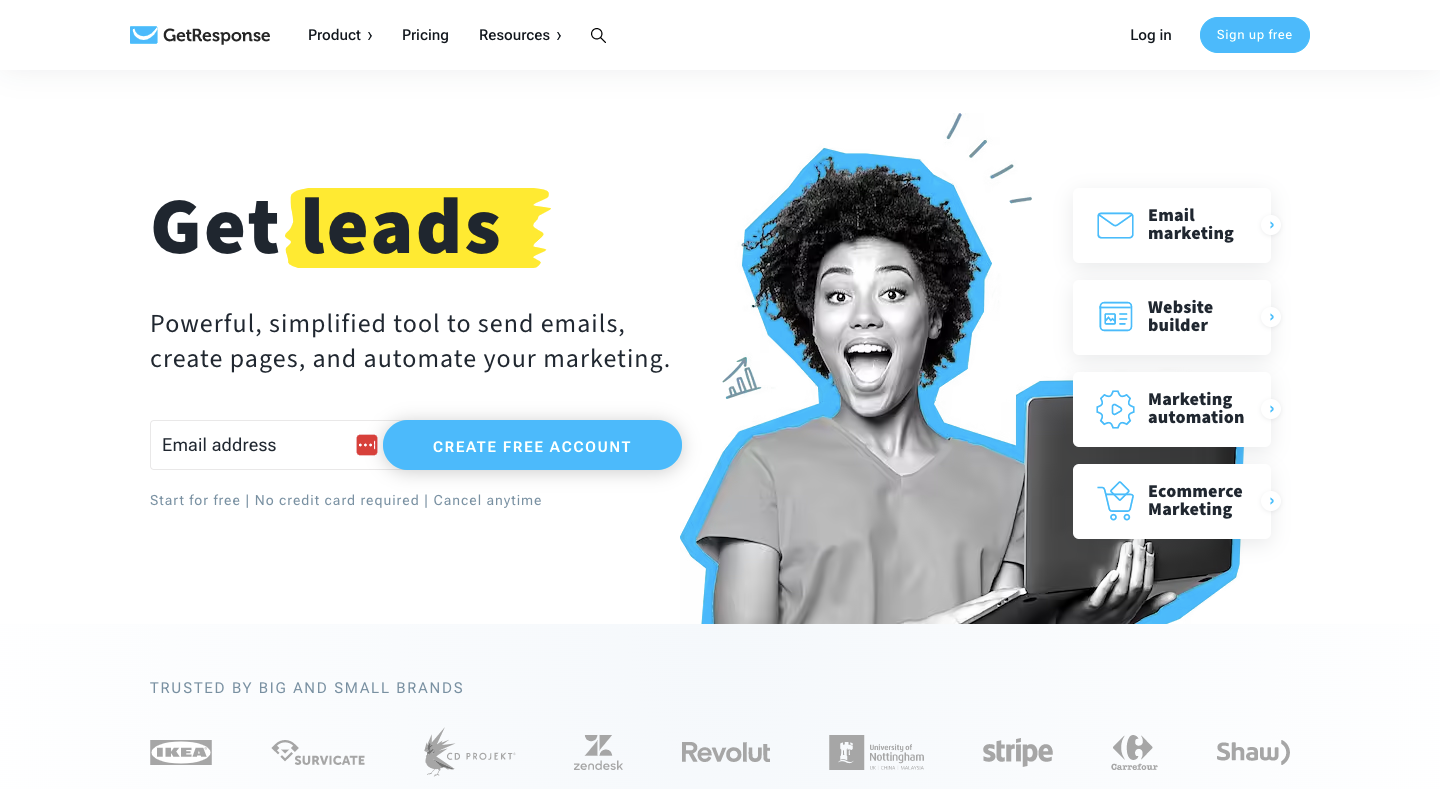 GetResponse is a marketing automation platform that allows marketers to reach and engage their audiences via email, SMS, and push notifications. It’s used by 350,000+ businesses, including the likes of Ikea and Zendesk.
GetResponse is a marketing automation platform that allows marketers to reach and engage their audiences via email, SMS, and push notifications. It’s used by 350,000+ businesses, including the likes of Ikea and Zendesk.
What Makes GetResponse the Best Sendinblue Alternative?
- Superb email deliverability. At time of writing, GetResponse sits proudly atop Email Deliverability Report’s deliverability ranking, whereas Sendinblue is down in mid-table.
- Built-in generative AI. Sendinblue is yet to join the generative AI revolution, whereas GetResponse has built its own GPT-3.5-powered email generator — available on all paid plans.
- Built-in webinar hosting. Run a lot of webinars? With GetResponse, you can host them from within the platform (provided you pay for one of the higher-tier plans). You’ll need a third-party integration to host webinars through Sendinblue.
- Manage paid ads through more platforms. Sendinblue customers can create and manage Facebook ads through the platform, whereas GetResponse offers built-in support for Google and Meta ads, offering more ways to reach new audiences and retarget previous website visitors.
- AI-driven website builder. GetResponse has an AI-powered website builder, allowing users to create their own websites without requiring any coding skills. It’s available on all GetResponse plans, even the free one. While Sendinblue does have a landing page builder, it’s less advanced and is only available at Business level and above.
How Does GetResponse Compare to Sendinblue?
| GetResponse | Sendinblue | |
| Best Feature | Built-in GPT-3.5-powered email generator. | Send transactional emails with guaranteed 97 percent deliverability. |
| Best For | Small businesses that need advanced marketing tools | Low-budget email marketing |
| Pros | Built-in generative AI and website builder; superb email deliverability. | Cheaper for brands with large email lists; free transactional emails on all plans. |
| Cons | More expensive for users with larger marketing lists. | Worse email deliverability and no free website builder. |
| Pricing/Month | Free for up to 500 contacts and 2,500 monthly email sends. Paid plans start at $15.58 per month for 1,000 contacts and unlimited email sends. | Free for unlimited contacts and up to 300 emails per day. Paid plans start at $25 per month for unlimited contacts and 20,000 emails per month. |
| Support | Paid plans include 24/7 support via chat and email. Phone support is only available at top-tier MAX2 level; some MAX2 customers can also access Slack support. | The $25+ per month Starter plan only offers email-based support. To receive personalized support, you’ll need to subscribe to an Enterprise plan. |
10. HubSpot
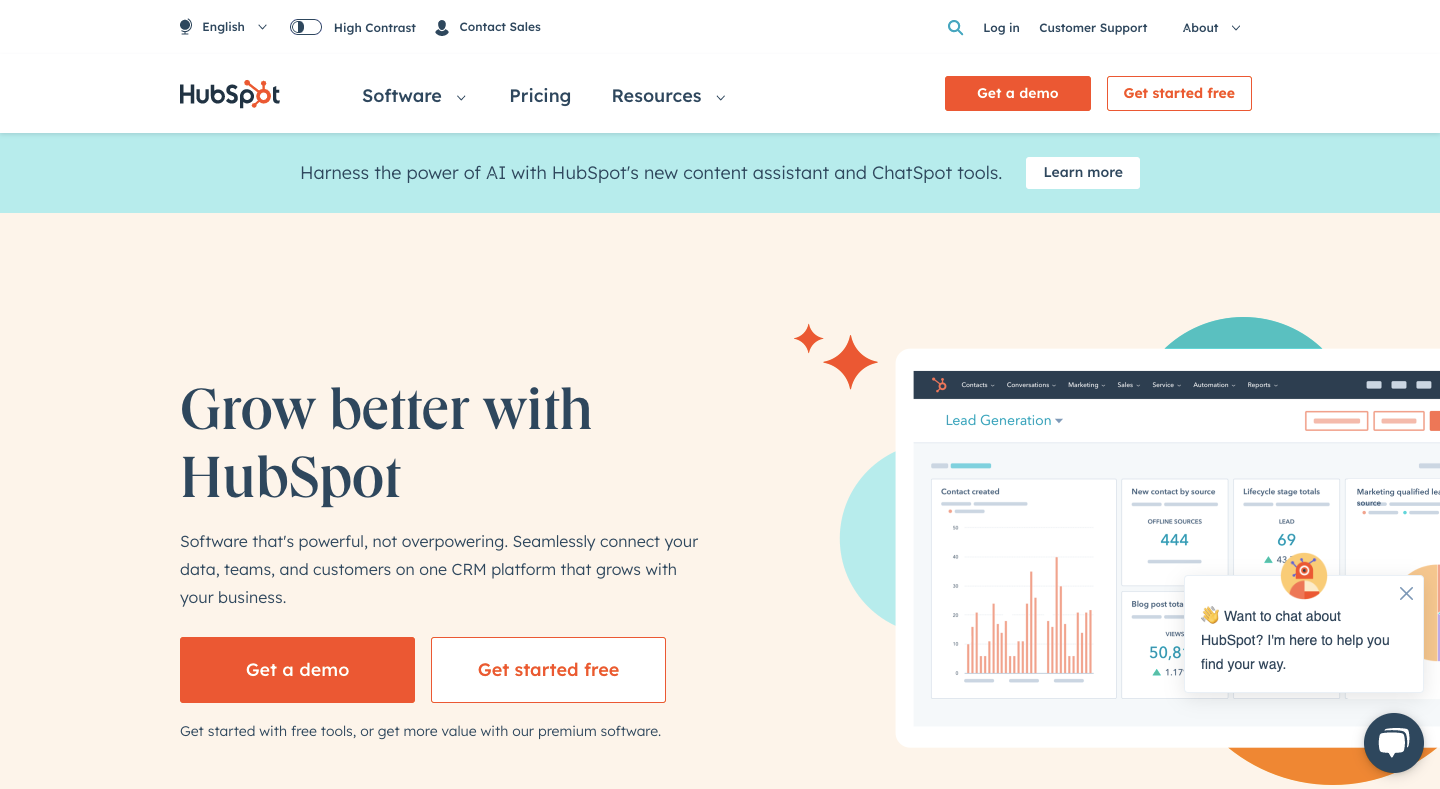 HubSpot offers more functionality than any other platform on this list, covering everything from sales and marketing to operations, customer support, and content management. So it’s hard to compare it to Sendinblue, which is predominantly a budget-friendly email marketing platform. But let’s try!
HubSpot offers more functionality than any other platform on this list, covering everything from sales and marketing to operations, customer support, and content management. So it’s hard to compare it to Sendinblue, which is predominantly a budget-friendly email marketing platform. But let’s try!
What Makes HubSpot the Best Sendinblue Alternative?
- Combine multiple business functions in a single platform. HubSpot’s biggest strength is its ability to integrate your sales, marketing, support, ops, and content management functions. Sendinblue offers plenty of fancy features, but it’s nowhere near as advanced or all-encompassing as HubSpot.
- More advanced (and free) CRM. Sendinblue has recently added its own CRM functionality, but it’s still some way behind HubSpot, one of the most popular free CRM platforms.
- Far more integrations. We’ve already pointed out that Sendinblue doesn’t have the most generous list of integrations, and it simply can’t compete with HubSpot’s 1,000+ integrations.
- Built-in social scheduling. Customers paying for HubSpot Marketing Hub Professional can connect up to 50 social media accounts and publish 10,000 social posts a month. They can even schedule posts up to three years in advance. Sendinblue’s social functionality is limited to running Facebook ads.
- Powerful analytics. HubSpot’s reporting is second to none, acting as a single source of truth for all your marketing, sales, and service data. Sendinblue’s analytics functionality is nowhere near as advanced.
How Does HubSpot Compare to Sendinblue?
| HubSpot | Sendinblue | |
| Best Feature | Connect marketing, sales, content management, and customer service in a single platform. | Send transactional emails with guaranteed 97 percent deliverability. |
| Best For | B2B inbound marketing | Low-budget email marketing |
| Pros | An all-in-one sales and marketing platform with an excellent (free) CRM. | Includes transactional emails and a CRM with all product tiers; much cheaper prices. |
| Cons | Expensive subscriptions and high onboarding fees. | More limited reporting; is basically “just” a marketing platform. |
| Pricing/Month | Free marketing plan includes unlimited contacts and 2,000 monthly email sends. Paid marketing plans start at $18 per month for 1,000 contacts and 5,000 monthly sends. | Free for unlimited contacts and up to 300 emails per day. Paid plans start at $25 per month for unlimited contacts and 20,000 emails per month. |
| Support | Paying customers can get 1:1 email and in-app chat support. Phone support is available at Pro level and above. | The $25+ per month Starter plan only offers email-based support. To receive personalized support, you’ll need to subscribe to an Enterprise plan. |
Frequently Asked Questions
Sendinblue is one of the best low-cost, generalist email marketing and automation platforms on the market. If you have a large email list and want to send high volumes of emails as cheaply as possible, it’s hard to beat. But there are plenty of Sendinblue alternatives that provide more advanced features and/or are better suited to brands in specific niches.
No! Google doesn’t have a Sendinblue alternative. However, if you’re desperate to use Gmail as a basic email marketing platform, you can do it through a third-party plugin.
Sendinblue is definitely one of the best-value email marketing and automation platforms. Whether it’s the best for you depends on your business and audience. If you have a comparatively small marketing list, there might be cheaper options available. And if you’re looking for an industry-specific tool (like a dedicated ecommerce automation platform), there are better options available.
Sendinblue’s biggest advantage is that it’s a fantastic (and low-cost) generalist email marketing platform. But that’s also its biggest weakness: if you need ecommerce-specific functionality, you’re better off with a dedicated tool like Drip, Klaviyo, or Omnisend. Sendinblue’s reporting is also pretty basic, with no social or ecommerce tracking, and it offers fewer integrations than most of its rivals.
Conclusion
In some ways, Sendinblue is a confusing platform.
It offers unlimited contacts on all paid plans, making it a superb fit for big brands with tens of thousands of email subscribers. But its main point of difference is its cheap pricing, which feels more relevant to smaller businesses.
At the same time, it lacks some of the advanced functionality of its more premium rivals. In particular, the lack of ecommerce tracking makes it a poor fit for ecommerce brands, which will be far better off with a specialist platform.
That’s where Drip comes in.
Ecommerce marketing is our whole thing, and we’re dedicated to helping brands like yours generate more sales and revenue.
See for yourself by signing up for your 14-day free trial today.
